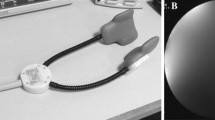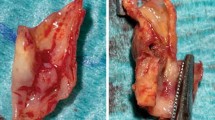Abstract
Carotid artery plaques with intraplaque haemorrhage or atheromatous debris have been found to be associated with an increased risk of embolic stroke. Other methods have failed to detect plaque morphology, and it is not clear whether MRI allows differentiation between prognostically and therapeutically relevant plaque types. We examined 17 carotid bifurcation plaques which had been removed in toto by MRI. For quantifying MR signal intensities (I) the contrast-to-noise ratio (CNR) was used: (ITissue-IRef)/SDRef, with normal saline (0.9%) as reference (Ref) and the standard deviation (SD) of the noise. Measurements were correlated with the histopathological appearance of “simple plaques”, consisting of fibrous intimal thickening, lipid deposits and/or atheromatous tissue with cholesterol crystals, largely calcified plaques, and “complicated plaques”, containing recent intramural haemorrhage or friable atheromatous debris. Significantly different mean CNR could be measured in the three plaque types on T1- and T2-weighted sequences (p<0.00001) and using the FLASH pulse sequence with a flip angle of 15° (p<0.001). With the T1-weighted sequence simple plaques showed a CNR of 4.4±2.3, calcified plaques −4.8±2.5 and complicated plaques 15.1±4.3. Using this technique, each single plaque could be correctly classified, an unalterable prerequisite for a clinical application. To date, motion artefacts due to patient movement or insufficiently triggerable vessel pulsation in combination with relative long acquisition times (6–7 min) have limited in vivo investigations. If these problems could be overcome, MRI might become a valuable technique for studying carotid plaque morphology.
Similar content being viewed by others
References
Lusby RJ, Ferrell LD, Wylie EJ (1983) The significance of intraplque hemorrhage in the pathogenesis of carotid atherosclerosis. In: Bergan JJ, Yao JST (eds) Cerebrovascular insufficiency. Grune & Stratton, New York, pp 41–55
NASCET collaborators (1991) Beneficial effect of carotid endarterectomy in symptomatic patients with high-grade carotid stenosis. N Engl J Med 325:445–453
European Carotid Surgery Trialists' Colloborative Group (1991) MRC European carotid surgery trial: interim results for symptomatic patients with severe (70–90%) or with mild (0–29%) carotid stenosis. Lancet 337:1235–1243
Imparato AM, Riles TS, Mintzer R, Baumann FG (1983) The importance of hemorrhage in the relationship between gross morphologic characteristics and cerebral symptoms in 376 carotid artery plaques. Ann Surg 197:195–203
Fischer M, Blumenfeld AM, Smith TW (1987) The importance of carotid artery plaque disruption and hemorrhage. Arch Neurol 44:1086–1089
AbuRahma AF, Boland JP, Robinson P, Decanio R (1990) Antiplatelet therapy and carotid plaque haemorrhage and its clinical implications. J Cardiovasc Surg 31:66–70
Schwartz RB, Jones KM, Chernoff DM, Mukherji SK, Khorasani R, Tice HM, Kikines R, Hooton SM, Stieg PE, Polak JF (1992) Common carotid artery bifurcation: evaluation with spiral CT. Radiology 185:513–519
Widder B, Paulat K, Hackspacher J, Hamann H, Hutschenreiter S, Kreutzer C, Ott F, Vollmar J (1990) Morphological characterization of carotid artery stenoses by ultrasound duplex scanning. Ultrasound Med Biol 16:349–354
Egglin TK, Rummeny E, Stark DD, Wittenberg J, Saini S, Ferrucci JT (1990) Hepatic tumors: quantitative tissue characterization with MR imaging. Radiology 176:107–110
Rummeny E, Weissleder R, Stark DD, Saini S, Compton CC, Bennett W, Hahn PF, Wittenberg J, Malt RA, Ferrucci JT (1989) Primary liver tumors: diagnosis by MR imaging. AJR 152:63–72
Poon CS, Bronskill MJ, Henkelman RM, Boyd NF (1992) Quantitative magnetic resonance imaging parameters and their relationship to mammographic pattern. J Natl Cancer Inst 84: 777–781
Negendank WG, Al-Katib AM, Karanes C, Smith MR (1990) Lymphomas: MR imaging contrast characteristics with clinical-pathologic correlations. Radiology 177:209–216
Hruban RH, Zerhouni EA, Dagher AP, Pessar ML, Hutchins GM (1987) Morphologic basis of MR imaging of benign prostatic hyperplasia. J Comput Assist Tomogr 11:1035–1041
Scholz TD, Vandenberg BF, Fleagle SR, Collins SM, Kerber RE, Skorton DJ (1990) Tissue characterization of chronic myocardial infarction. Invest Radiol 25:1120–1124
Modl JM, Sether LA, Haughton VM, Kneeland JB (1991) Articular cartilage: correlation of histologic zones with signal intensity at MR imaging. Radiology 181:853–855
Vinitski S, Macke Consigny P, Shapiro MJ, Janes N, Smullens SN, Rifkin MD (1991) Magnetic resonance chemical shift imaging and spectroscopy of atherosclerotic plaque. Invest Radiol 26:703–714
Altbach MI, Mattingly MA, Brown MF, Gmitro AF (1991) Magnetic resonance imaging of lipid deposits in human atheroma via a stimulated-echo diffussion-weighted technique. Magn Reson Med 20:319–326
Maynor CH, Charles HC, Herfkens RJ, Suddarth SA, Johnson GA (1989) Chemical shift imaging of atherosclerosis at 7.0 Tesla. Invest Radiol 24:52–60
Small DM (1988) Progression and regression of atherosclerotic lesions. Insights from lipid physical biochemistry. Arteriosclerosis 8:103–129
Widder B, Friedrich JM, Paulat K, Hamann H, Hutschenreiter S, Kreutzer C, Ott F, Arlart IP (1987) Evaluation of the degree of carotid artery stenoses: ultrasound and iv-DSA versus surgical specimens. Ultraschall 8:82–86
Görtler M, Niethammer R, Widder B (1994) Differentiating subtotal carotid artery stenosis from occlusions by colour-coded duplex sonography. J Neurol 241:301–305
Thickman DI, Kundel HL, Wolf G (1983) Nuclear magnetic resonance characteristics of fresh and fixed tissue: the effect of elapsed time. Radiology 148:183–185
Kamman RL, Go KG, Stomp GP, Hulsaert CE, Berendsen HJC (1985) Changes of relaxation times T1 and T2 in rat tissues after biopsy and fixation. Magn Reson Imaging 3:245–250
Moser E, Holzmueller P, Gomiscek G (1992) Liver tissue characterization by in vitro NMR: tissue handling and biological variation. Magn Reson Med 24: 213–220
Stark DD, Wittenberg J, Edelman RR (1986) Detection of hepatic metastases: analysis of pulse sequence performance in MR imaging. Radiology 159:365–370
Author information
Authors and Affiliations
Rights and permissions
About this article
Cite this article
Görtler, M., Goldmann, A., Mohr, W. et al. Tissue characterisation of atherosclerotic carotid plaques by MRI. Neuroradiology 37, 631–635 (1995). https://doi.org/10.1007/BF00593376
Received:
Accepted:
Issue Date:
DOI: https://doi.org/10.1007/BF00593376




